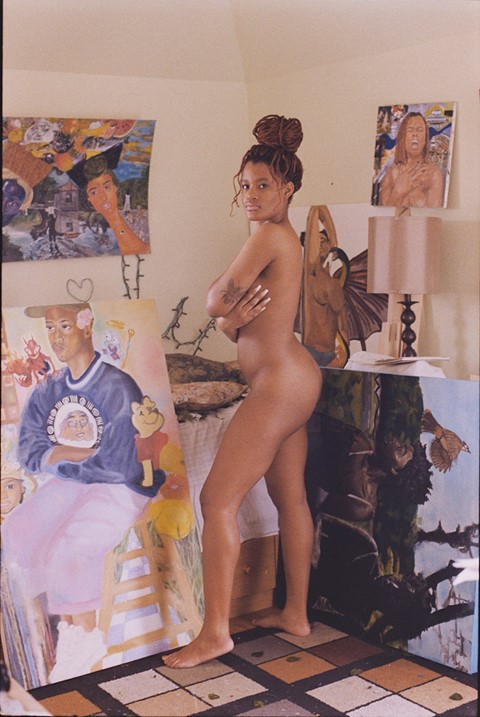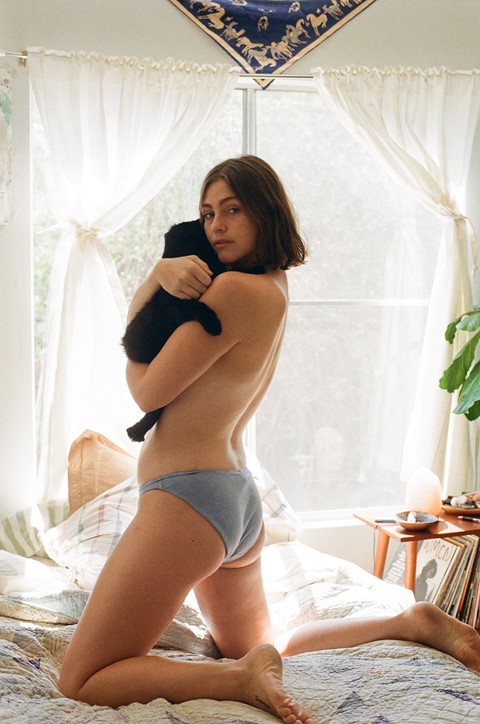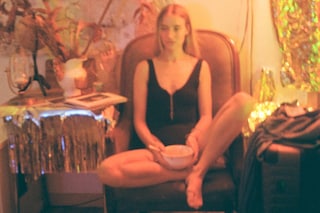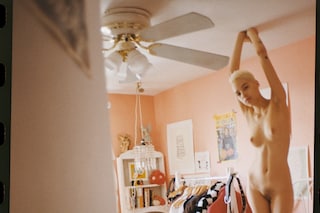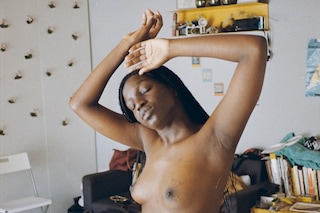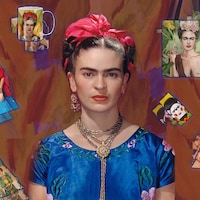Photographer Maria Clara Macrì travelled across the world to capture women at ease and in their safe spaces
Born and raised in Italy, Maria Clara Macrì began to travel the world to meet women from other cultures who, crossing her “lonely path and destiny”, would be willing to take part in her photography projects.
Since 2018, the photographer has been restlessly looking for destinations that could grant her the chance to encounter her next subject. Whether it was Milan or Paris, New York or Los Angeles, what mattered to Macrì was to be able to fully grasp and visually express the complex and intense nature of femininity today.
Focusing on the evolving visual portrayal of the female universe, the photographer’s latest project, In Her Room, explores the relationship between empathy, intimacy, and the contemporary representation of women. Macrì chose to capture her subjects within their own bedrooms, seeing each of those rooms as a safe space where women can experiment with, and discover, their identity for the very first time.
The result is a series of nudes that – featuring girls from all cultures and walks of life – reflects women’s uniqueness. Entirely shot on film, In Her Rooms will soon become a book.
Below, we speak with Maria Clara Macrì about the importance of countering the mainstream representation of women, the phenomenon of female migration, and the relevance that In Her Rooms has for everyone going through social isolation.
“I could see how each of those women had something that resonated with me. Somehow, they were all reflections of myself” – Maria Clara Macrì
In Her Rooms was shot by yourself all around the world and it features girls coming from all sorts of countries, backgrounds, and ethnicities. What did you want to capture in those rooms?
Maria Clara Macrì: At the beginning of this adventure, I wanted to find the new woman, the woman of the millennium, the one that is striving for freedom just standing for the right to be exactly who she wants to be. I was looking for women that are uninterested in having a marketable value, women that do not recognise themselves in the stereotyped, sexualised images that mainstream media force onto us. I was looking for women that, for these exact reasons, are willing to write a new chapter in the history of humanity.
Going from one room to the other, I realised that my work was also capturing a new kind of relationship, namely the relationship between women and their domestic space. A relationship that, despite conserving an ancestral nature, is no longer determined by historical traditions or gender stereotypes, but brand-new.
Throughout the project, I came to understand that my subjects were showing me what binds us, women from across the world, to one another. Working with them, I could see how each of those women had something that resonated with me. Somehow, they were all reflections of myself. Every time I would meet one of my subjects, I would become more aware of who I am, losing and finding myself again while entering those rooms. Shooting this series enabled me to capture the seeds of a revolution and the fruits are soon to be blossoming.

Where does In Her Rooms stand in relation to today’s mainstream representation of womanhood? And is there a specific reason why you chose female nudes over other ways of representing women?
Maria Clara Macrì: Although today the diverse faces of womanhood are being more often recognised and represented in the media, the mainstream conception of women’s image is still dominated by sexualising and objectifying portrayals of the female body. I believe this to be strictly linked to the mentality that lies behind the production of such images, which is largely subordinate to the logic of marketing and profit. In Her Rooms has recently attracted more attention, and I think that that is because the goal of this series was not to sell a product. The project was not inspired by a personal economic gain but by the empathy and solidarity I felt towards all women in the world. The series was born by the passion I put into strongly believing that it is time to finally witness the liberation of women’s bodies and identities. In Her Rooms is a cultural experiment where women are photographed not to please the market, but to raise public awareness of the beauty that characterises every human being.
You identify as queer and non-binary. Has your portrayal of women in this series been shaped by any specific queer values? Could you give us some concrete examples of how that’s reflected in the series?
Maria Clara Macrì: Queer means above all inclusion, respect of each other’s differences, and freedom. This is the perspective, the lens through which I observe the world, that is also the perspective I used to shoot In Her Rooms. Given that I define myself as queer not only because of my sexual orientation but especially for my personal way of being – which is reflected in each one of my projects – I believe In Her Rooms and all women I portrayed to be just as queer as I am.
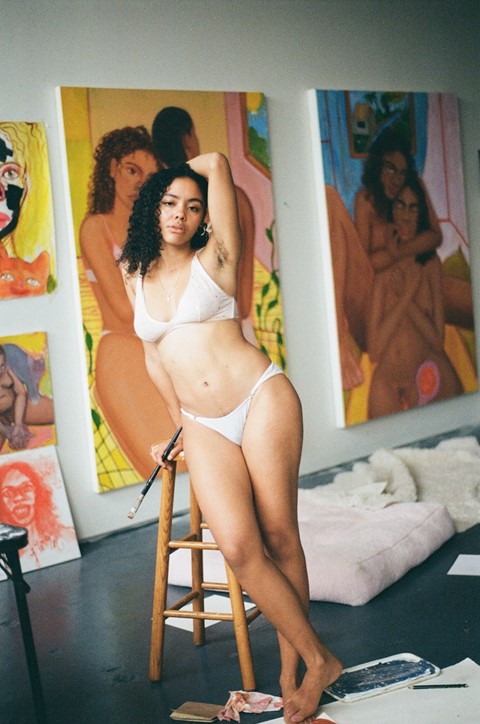
You’ve mentioned that most of the girls featured in your project weren’t born in the cities where you’ve met them. Did the shared experience of moving cities help you feel at ease while interacting with the girls you photographed?
Maria Clara Macrì: Lots of young women are forced to leave their birthplaces to find their real paths, to follow their dreams. This is also my story, as their journeys become part of mine. ‘As a woman I have no country, as a woman I want no country, as a woman my country is the whole world,’ Virginia Woolf said. This is how we feel and this is also how we recognise ourselves as sisters.
What criteria guided you through the selection of your subjects?
Maria Clara Macrì: To some extent, this project was guided by destiny. I chose my subjects based on the empathetic feelings that attracted me to them, or them to me. I believe that this strong energy I call empathy recognises and attracts people who share similar experiences and, sometimes, even similar physical characteristics. So destiny and empathy played a big role in this project, although when it came to selecting my subjects, I also had some specific features in my mind. My interest always goes to faces that reveal a mixture of different backgrounds, to gazes that reveal deepness or strength. To ways of walking that show a nature exceeding what one is wearing, so that I know for sure that, once nude, that person will still have the same authenticity, just wearing her skin. I chose big cities because I know that is where the vanguards first take place. That is where the new generations from all over the world go to create new cultures and values necessary to defend their own rights. I wanted to visit places that are far from my own homeland to then come back and realise that, from New York to Milan, there is not so much of a difference in being a woman nowadays.

You said that the girls featured in the series described the shootings as “liberating sessions”. Could you give us any insights on the behind-the-scenes of In Her Rooms?
Maria Clara Macrì: In the first part of my trip I was planning most of the shoots via Instagram, but then I just freely abandoned myself to my destiny. I felt this was the right choice as I wanted coherence when it came to the freedom of the women I was going to capture, as well as to the freedom of my own journey. I didn’t want anything to be planned, as it was that specific freedom that linked the chaos of those girls’ rooms to the chaos of my own life, and to that of life itself. I travelled, being hosted by strangers and, sometimes, my subjects would be generous enough to offer me a couch to crash on. I met one of my subjects in Los Angeles after asking a guy with a guitar at a crossroads if he could suggest to me a nice bar where to spend the evening. He then invited me to his house party in Beverly Hills, and that’s where, as soon as I stepped into his villa, I saw Leila for the first time. A week later, she sent me a DM on Instagram saying that she was interested in taking part in my project and free to shoot that day, so I just ran to her. We had the shooting that same day, but I stayed with her for two days dancing, laughing, and eating delicious food. We basically became sisters.
When I still was in LA, Monica Hernandez replied to an email I had sent her a year before that saying that she would be able to shoot the following week. So I took a plane back to NY, although that wasn’t my original plan. Monica was my link to Leandra, but I won’t tell you more about the book. I don’t want to spoiler too much of the crazy stories behind In Her Rooms. Since every shooting turned into a dialogue, I had brilliant conversations with all of them. Morena helped me decide whether I should fly back to Italy the day after our shooting or follow my instinct and burn the ticket. She explained to me why she thought it was time to go back, but then she added “your inner voice will show up and decide for you. Regardless of what I or your reason can say, at some point, you will know that that was the best decision you could take.” So I burned my ticket and, the morning after that day, the rain made me encounter my next subject at my favourite coffee shop in Bushwick.
“Your room is a space of freedom where you can create, write, and read while remaining in touch with your own body and energy” – Maria Clara Macrì
Would you say that In Her Rooms could encourage people to work on the relationship they have with their own body, ideas, and personality – hence inspiring people to use their quarantine to rediscover themselves – by celebrating the stories and the personalities that are hidden within the walls of those girls’ bedrooms?
Maria Clara Macrì: Definitely. When the quarantine started, I was hit by a form of anxiety that I had never felt before. I was completely shocked, as I guess everyone else was. In the first days of isolation, I couldn’t recognise myself, I was lost and detached. Then I felt the need to look at my handbook, to look at all of them, all of my women, who were there to help me. They reminded me that home is the shelter where you can expand the knowledge you have of yourself and the one you have of the world. Your room is a space of freedom where you can create, write, and read while remaining in touch with your own body and energy. Those women are in my book to remind me that the deepest and most truthful inviolability of freedom resides in our minds and souls, and so in our bodies. The love for life that these women have taught me is an invitation for everyone to react positively to the crisis. To stay inside our rooms will prepare us for the cultural Renaissance that will take place once this has passed. To be able to take care of our bodies and listen to their new needs day after day is, right now, an act of love for the whole community. We need to face this time of crisis and change being aware of its dark sides, but also embracing the light and the cultural rebirth that this can bring about.
